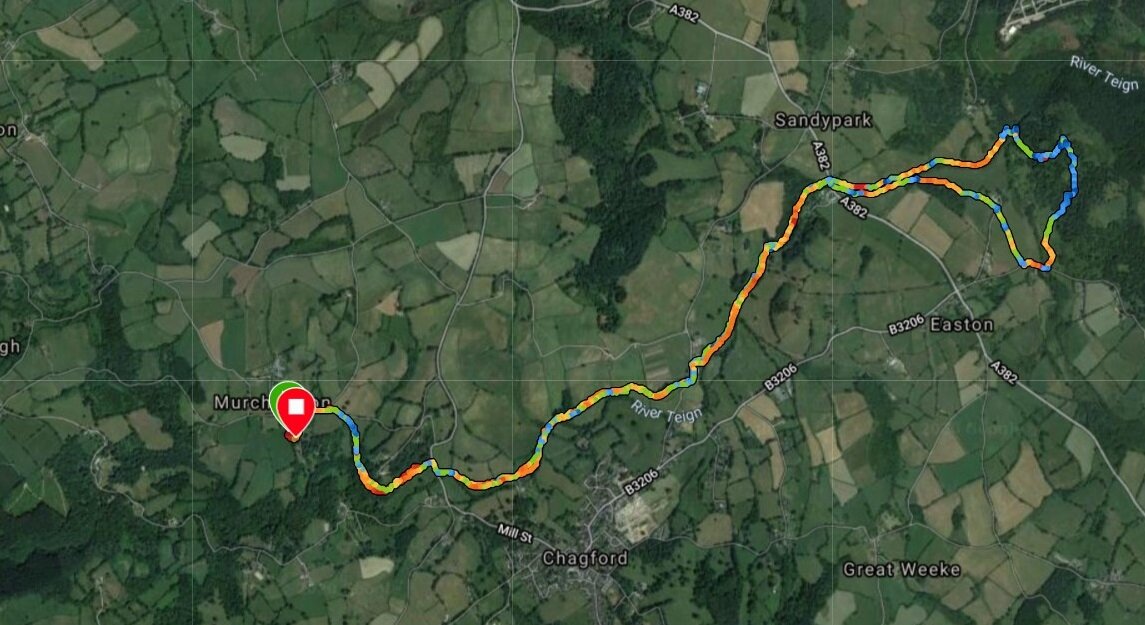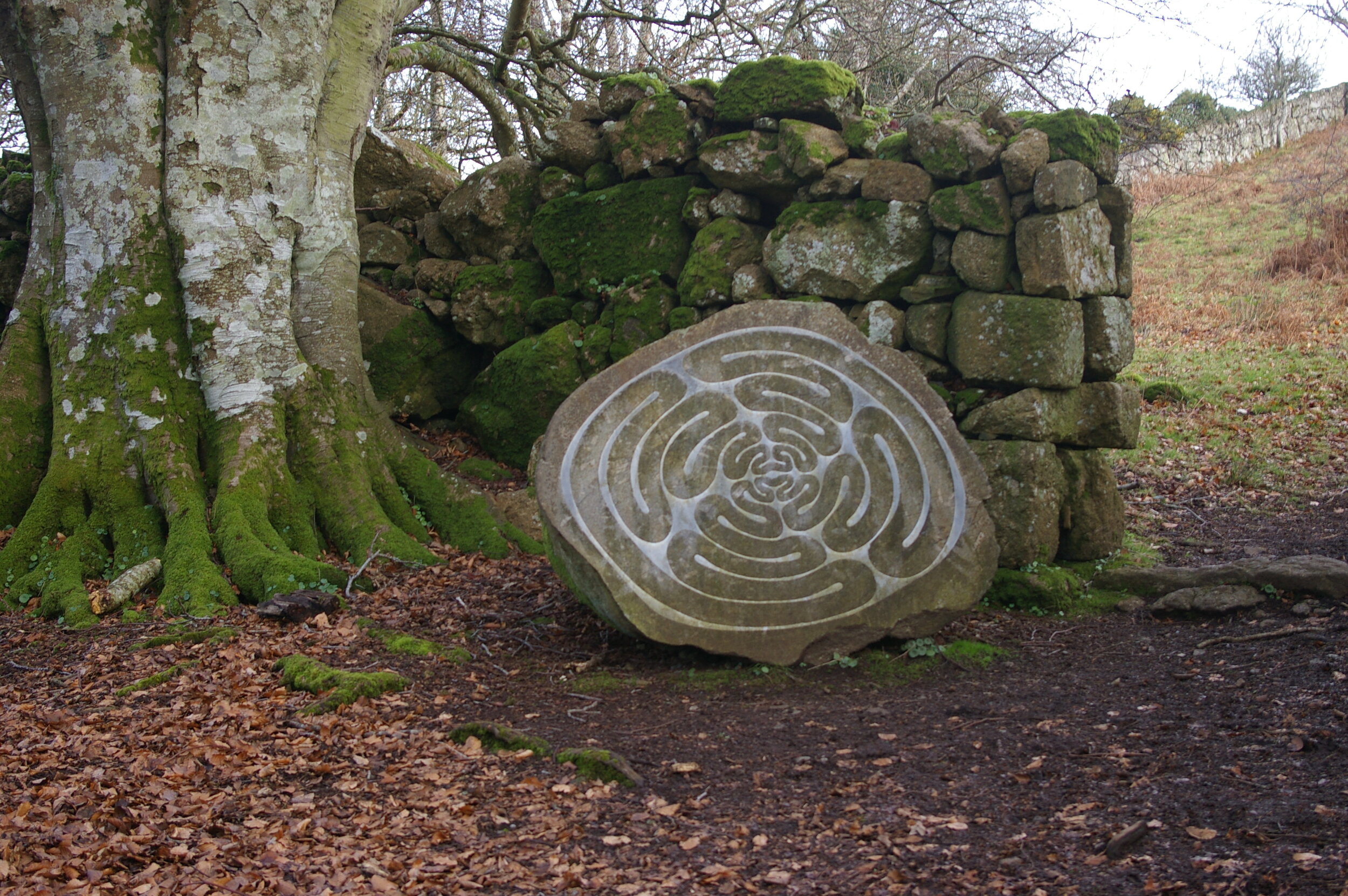7.8 miles, 3 hours 5 minutes, Elevation gain 202 m
Directions
From Murchington head past the former chapel towards Chagford (keep straight ahead rather than following the road left). At the top of an incline, before the road begins a steep drop, take the footpath to the right across the field to Warcleave Wood. After crossing a small stream, walk through the wood, past Warcleave Cottage (NT) hidden in the trees to the right, until you come out on to the road again. Turn right, but as you come to the ancient Chagford Bridge take the footpath on the left that follows the river downstream. Follow the river for about a mile. After a few hundred metres the building to your right is the historic Chagford Woollen Mill, note the mill leat flowing back into the Teign just beyond the factory block. The building has been skillfully reconstructed into six residential properties.
When you come to a weir the footpath leaves the river, following instead the course of Rushford Mill leat (which now supplies the water for Chagford’s outdoor swimming pool (May to September)). Follow this leat for a few hundred metres through two large fields with a red-roofed farm on the horizon (Chagfood Community farm). At the end of the second field pass through the gate and cross the footbridge over the leat.
The footbridge over Rushford Mill leat
Officially, the footpath crosses the next field south-east, back towards the river (through a gap in the far hedge) and onto the road near Rushford Bridge, but recently it has been made possible to follow the course of the leat directly to the road - crossing the fence where the barbed wire has been cut and a gate has been placed to aid crossing. You are now opposite Chagford swimming pool. Head left along the road for about 100 metres. Note the semi-detached cottages opposite the pool complete with their small granite houses for fattening a pig (apparently). At Rushford Mill Farm head right, passing through the farmyard to leave by the large gate that opens into the big field beyond (in the farmyard note the stepping stones across the Teign to the right which would take you up to the B3206).
Follow the well-worn path across the middle of this big field till it rejoins the river bank. The impressive farm on the hill to your left is Rushford Barton. Keep close by the river till you come to a gate into a wood. The small island in the river is home to ‘Granite Song’ (1991), the first of the Randall-Page sculptures (see below).
Peter Randall-Pages’s ‘Granite Song’ on its island in the Teign. The tree trunk is the result of a recent storm.
Return to the footpath, which continues to stick close by the river. On the opposite bank of the river you will see Mill End Hotel, with its attractive gardens. After you cross a footbridge over a small stream walk through the next field and cross the A382 at Dogmarsh Bridge. The hamlet to your left is Sandy Bridge, with its popular local pub. The field you have now entered is the site of the Chagford Show which is held every August (except in 2020 of course). Keep close by the river for a kilometre. You are now entering the Castle Drogo estate (NT), although Lutyens’ impressive early 20th-century house, perched high on the hilltop, is hard to see even in winter. As you come into the wooded gorge cut by the river, take the raised footbridge to your right to cross the Teign (if you want to visit Drogo follow the track to your left or clamber up the very steep paths that offer more direct access to the house and garden).
Once you have crossed the river head left for a about twenty metres and then take the path on the right that heads back on itself as it tracks uphill. You are now in the historic Whiddon Deer Park. Follow the path steeply uphill though a mix of bracken and upland woodland for about ten minutes. Eventually you will come to a grand beech avenue including some badly storm-damaged trees that must be 250 years old or more. At the far end of this avenue you will see ‘Passage’, the second Randall-Page scuplture, nestled either side of an old granite gateway. This beautiful and peaceful spot is a great place to stop for a picnic. It also offers great views back to Castle Drogo from the end of the wall to the left of ‘Passage’.
Peter Randall-Page’s ‘Passage’, 1992 in Whiddon Deer Park near Drewsteignton
You could now return the way you came, but we would recommend heading right from ‘Passage’, broadly following the direction of the granite wall, past amazing old oaks, till you come out into a large pasture field. This is all access land so head across the field to join the major path that heads south towards the road at Forder. At the road, turn right, walking past Forder on your left (with its microwave postbox) and a few metres later take the footpath on the right into the large field below Whiddon Farm. Head across this field towards the attractive, mullioned house straight ahead (Whiddon Park House). Cross the drive to this house to take the footpath opposite. Note the well maintained hedges on either side of the footpath at this point- a rare example of traditional hedge-laying. After about 300 metres you come to a set of steep steps on your right that drop down towards the river. At the bottom head left back upstream till you return to Dogmarsh Bridge and the Mill End Hotel. From here trace your route back to Murhcington, first along the river and then back through Warcleave Wood. Alternatively, at Rushford Mill Farm, you can follow the road past the swimming pool and up hill to Chagford if you want to shop or grab a drink/meal in town.
Peter Randall-Page
This walk includes two sculptures by Peter Randall-Page: Granite Song, and Passage. The first is on a small island on the River Teign next to a weir, on land owned by Jane Hayter-Hames. The second is either side of an opening in a wall in Whiddon Deer Park. Both sculptures are created from a large granite boulder which has been split in half. The resulting symmetrical faces have then been inscribed with a meandering, almost aboriginal, line in mirror image - the grooves have then been filled with melted lead. It is as though the granite has simply been split to reveal what was always there, timeless but obscured. Although this is reminiscent of splitting limestone to reveal an ammonite, granite is a much older rock that pre-dates fossils. As Marina Warner writes, the granite is "revivified, becoming part of the narrative, occurring in the present time, of the visitor who breaks a path in the bracken to see it" (p24 Randall-Page and Chapman, Granite Song 1999).




